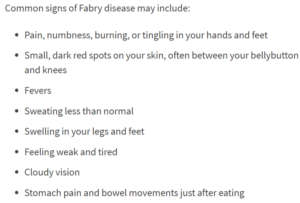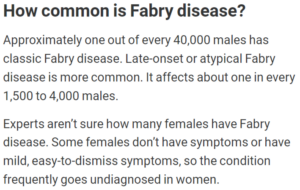When I was four years old, my mother noticed that I didn’t sweat.
For any other parent, this would be an alarming and mysterious symptom, but in my family, it was too familiar.
She knew right away that I inherited the disease that has plagued my relatives for at least five generations, but it would take three more years for me to officially be diagnosed with Fabry disease, a rare genetic, metabolic disorder.
I remember first learning about Fabry disease when I was a young boy and my grandfather was diagnosed.
He spent the first 48 years of his life baffling doctors with his unusual symptoms, and he eventually passed away from complications at age 53.
Fabry disease occurs when the body does not produce enough working copies of alpha-gal A, an enzyme that breaks down a fatty lipid so its parts can be reused by the body.
As a result, the lipid builds up in cells throughout the body and has the potential to damage nearly every organ.

The wide variety of symptoms that result paired with rarity of the condition often lead to patients going undiagnosed or misdiagnosed for many years — I’m lucky that I was diagnosed relatively quickly.
Fabry disease affects people in a variety of ways. Some people experience kidney issues or changes in their heart rhythms.
For me, I started experiencing symptoms at age seven when I would be hit with repeated excruciating bouts of pain in my hands and feet — these crises would knock me off my feet for up to four days at a time.

Treatments for Fabry disease would not become available until the early 2000s, so at the time. my doctors did their best to help manage my symptoms with anti-seizure medications and strong pain relievers.
I tried to cope with my inability to sweat by taking cold baths throughout the day.
Eventually, my symptoms got to a point where I was not physically able to carry on my family’s farming business.
There are many people who may not be aware of a family history of Fabry disease and thus are not fortunate enough to get a diagnosis early in life like myself.
To support others impacted by this debilitating disease and increase education and awareness, I founded the Fabry Support & Information Group (FSIG) in 1996 and am now the executive director.
The organization has connected thousands of patients and caregivers from more than 45 countries and enables members to share their experiences openly.
We have played a leading role in increasing the medical community’s understanding of Fabry disease. and I am extremely proud of the work we have done and will continue to do.
While research has come a long way in helping Fabry patients better manage their symptoms, we are dedicated to advocating for the need for additional treatment options.
Available therapies can be burdensome because they often require patients to travel to hospitals every two weeks for time-consuming infusion therapies or follow a strict meal schedule.
If we continue our work to build awareness and understanding of the challenges Fabry disease presents, and promising research advances, there is hope for a better and brighter future for the Fabry community.










































